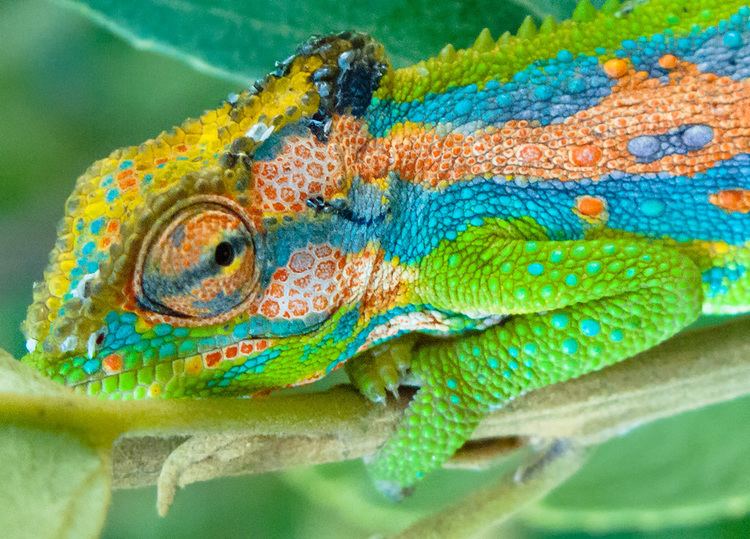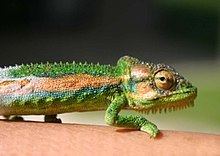Suborder Iguania Subfamily Chamaeleoninae Higher classification Bradypodion | ||
 | ||
Similar Bradypodion, Chameleons, Reptile, Natal Midlands dwarf cha, Marshall's pygmy chameleon | ||
Live birth bradypodion pumilum the cape dwarf chameleon
The Cape dwarf chameleon (Bradypodion pumilum), is a chameleon native to the South African province of the Western Cape, where it is restricted to the region around Cape Town.
Contents
- Live birth bradypodion pumilum the cape dwarf chameleon
- Atmosphere chameleons baby cape dwarf chameleons eating
- Description
- Taxonomy
- Distribution
- Habitat in wilderness areas
- Habitat in urban areas
- Urban habitat requirements
- Urban threats
- Behaviour
- Chameleons in captivity
- References

As with most chameleons, its tongue is twice the length of its body and it can be shot out of its mouth using a special muscle in the jaw. This gives the chameleon the ability to catch insects some distance away.

Atmosphere chameleons baby cape dwarf chameleons eating
Description

The Cape dwarf chameleon is known to grow over 15 cm (5.9 in) in length, including the tail, with males and females reaching similar adult sizes. They are ovoviviparous, but examination in controlled captivity has shown the very soft egg-like membrane around the young is discarded immediately on birth. The young resemble miniature versions of the adults, with muted colours, and typically reach no more than 2 cm in length at birth. Adults can vary quite significantly in colour variety, saturation and pattern, some appearing much more vibrant than others. Like most chameleons, the tail is prehensile, and the feet are well evolved to grasping twigs, with minute claws on the end that improve grip.

Normally very slow moving, chameleons have a characteristic shake, which may make them look more like leaves to prey and predators. When provoked, they can speed up to several centimetres a second. When further provoked, they inflate themselves, hiss, change colour dramatically, and bite. They do not have sharp teeth, so their bites rarely inflict more than a slight pinch.

Male and female are difficult to differentiate. However males tend to have brighter colours, slightly larger head crests, and slightly narrower stomach area around the hips.
Taxonomy
In the past, most South African dwarf chameleons were considered a subspecies of the Cape species This is now known to be wrong, however; B. pumilum does not appear to have any particularly close living relatives. Like the Knysna dwarf chameleon, it seems to be a basal offshoot of the ancestral stock, which gave rise to all Bradypodion species.
Distribution
The Cape dwarf chameleon is restricted to the area around Cape Town, the Boland, and the mountainous coastline as far as Agulhas.
Habitat in wilderness areas
This species inhabits a range of different habitats and vegetation types, from fynbos and renosterveld, to indigenous Afrotemperate forest and wetlands.
It is less common in extremely fire-prone and low-growing fynbos, and in open sandy or rocky areas. It is more usually found in areas such as river valleys, which are sheltered to some degree from the region's seasonal fires, and where more dense vegetation has developed. It prefers certain plant species to reside on too, especially favouring Restios. This adaptable species has also diversified into different forms and colours, depending on their habitat. Those that live in open, low-lying fynbos vegetation tend to be smaller and dull-coloured with smaller crests. Those in denser, closed vegetation areas tend to be larger and brightly coloured, with a longer tail and larger casque.
In the wild, its predators are mainly snakes and predatory birds such as Fiscal shrikes.
Habitat in urban areas
With much of their former habitat now covered in suburbs, this little species has shown itself partially adaptable to suburban gardens. They can serve as a natural insect control for gardens. However, not all gardens are suitable.
Urban habitat requirements
Chameleons survive only in sunny gardens with lots of bushy and varied vegetation.
Direct sunlight is a prerequisite for cold-blooded reptiles like chameleons. Chameleons also require vegetation for a habitat—preferably with foliage they can easily grasp with their small claws, and perch on. Therefore, most suitable are bushes and small trees with some fine foliage or thin twigs for climbing. Favoured local shrub species include: Restio reeds, daisy bushes, Leonotis bushes, Cape Honeysuckle, Plumbago, Bitou bushes, Psoralea pinnata and many others. Favoured trees are those which provide low and accessible foliage, such as Karee trees, Willows, Pepper trees, Virgilia and others.
Terrains with no suitable habitat include lawns, paved areas, brickwork, or higher trees with trunks too wide for chameleons to climb. Foliage should also not be pruned or trimmed, or exposed to insecticide poisons, as this usually kills or injures chameleons.
Chameleons naturally wander and, in suburbs with smaller gardens, they also avoid properties that don't connect to larger "green corridors" that join several properties.
Urban threats
In urban areas, its predators are mainly domestic cats. Cats are a non-native, introduced predator that chameleons are defenseless against. More importantly, the growing density of cats kept in suburban areas causes an unnaturally high ratio of predators to prey, leading to the collapse of populations of chameleons and many other species. Other predators include a range of urban and introduced bird species such as crows.
Certain gardening practices such as using insecticides or hedge trimmers can also kill off urban populations. Garden clearing removes habitat, especially when greenery is replaced with paving, brickwork or lawns. Occasionally chameleons are also known to transported on garden waste, to waste disposal sites.
Behaviour
Chameleons sometimes change their color for camouflage, to match the environment, but is also more often used as a way of expressing mood and communicating.
Courtship involves small, quick head twitches by the male, who exhibits brighter courtship colours. If the female rejects the male's advances, she assumes a much darker colour, sway from side to side, and often open her mouth threateningly. Darker colours are often associated with stress, and lighter colours with relaxation or sleep.
During the night, the species tends to move higher, to the tips of branches (nocturnal predators are primarily terrestrial) and assume a white colour when they sleep. During the day they spend more time lower down in denser vegetation (daytime predators include several species of birds).
They feed primarily on small insects and other arthropods. They drink by licking dew or rain drops from leaves or other surfaces.
Chameleons in captivity
While it is not normally legal to keep these chameleons, it is possible to obtain special permission from the South African government to do so. These chameleons are better admired than handled. However, taming is possible through gentle and consistent (almost daily) contact, allowing trust to build up. This is typically achieved through careful and slow hand-based feeding of flies, small spiders, grasshoppers, etc. In cold weather, a sensitively handled B. pumilum commonly becomes eager to perch on a human hand for the warmth. To maintain them out of their natural environment requires advanced skills and is a demanding project; they require the right amount and type of ultraviolet exposure and large supplies of specific types of live food that are not easy to supply. They also require moisture, even just tap water sprayed gently onto the foliage with a hose.
In most urban environments, the amount of naturally occurring suitable insect food is insufficient. They should remain outdoors where they are able to regulate their own body temperatures using sunlight (like most reptiles, they die if deprived of, or overexposed to the sun).
Cat owners should be aware that domestic cats are introduced predators, and usually kill all chameleons in the immediate area. Consequently, one should not bring chameleons into a garden frequented by cats. It also is important to be cautious of the activity of shrikes, in particular the southern fiscal, which, if they get into the chameleon-hunting habit, will rapidly strip a garden.
